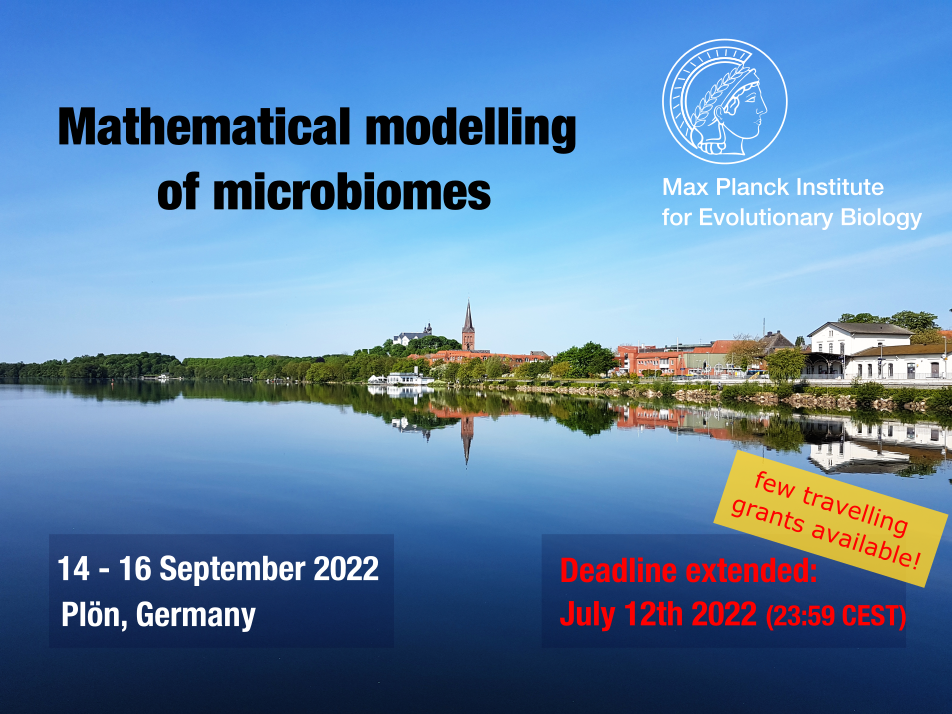Speaker
Description
Authors: Ghjuvan Grimaud, Thomas Koffel, Elena Litchman, Christopher Klausmeier
Genome-scale metabolic models (GEMs) are a powerful tool to understand and predict the metabolic status of bacterial species in different environmental conditions (Terzer et al., 2009). GEMs simulated using constraint-based models such as Flux Balance Analysis (FBA) (Orth et al., 2010a) or Dynamical Flux Balance Analysis (dFBA) (Mahadevan et al., 2002) make testable predictions and are used to answer different metabolic engineering, bioprocessing or ecological questions. Here we ask the question: can GEMs be used to model the evolution of metabolic networks in realistic ecological conditions, taking the cost and number of mutations into account? We propose a new approach combining FBA/dFBA and the adaptive dynamics theory (Geritz et al., 1998) to simulate the evolution of GEMs in an eco-evolutionary framework. We start with a GEM in a defined environment, called the resident. At each evolutionary time step, we create a mutant by adding one or several reaction(s) to the resident GEM corresponding to one or several mutation(s) chosen from a matrix containing all the known metabolic reactions in prokaryotes or a subset of this matrix, in line with Zomorrodi et al. (2014) and Szappanos et al. (2016). Then, we perform dFBA on the competing mutant/resident system. The strain(s) (resident or mutant) with the higher growth rate or winning the competition becomes the new resident(s). We then proceed to the next evolutionary time-step. By doing this evolutionary cycle iteratively, we can study the evolution of metabolic networks until an evolutionary equilibrium is reached, taking ecological feedbacks into account. Here we present the results of this method applied to Escherichia coli core model, a simplified version of the genome-scale metabolic model of E. coli iAF1260 with only 95 reactions and 72 metabolites (Orth et al., 2010b). We investigate whether the evolutionary outcome (e.g. number of strains and “functional” profile of the community at the evolutionary equilibrium) depends on the number of reactions added to the mutant at each evolutionary time step (i.e., number of mutations) or on the cost of adding new reactions. The results show that the optimal number of reactions added at each time step depends on the ecological conditions, thus revealing what conditions favor Horizontal Gene Transfer (when many mutations are optimal). When new reactions are costly, a trade-off between the number of reactions and their associated cost emerges, and the final complexity of the metabolic network ultimately depends on this trade-off and the environmental conditions. References Cited Geritz, S.a.H., Kisdi, E., Meszena, G., and Metz, J.a.J. (1998). Evolutionary singular strategies and the adaptive growth and branching of the evolutionary tree. Evolutionary Ecology 12, 35-57. Mahadevan, R., Edwards, J.S., and Doyle, F.J. (2002). Dynamic flux balance analysis of diauxic growth in Escherichia coli. Biophysical journal 83, 1331-1340. O’brien, E.J., Monk, J.M., and Palsson, B.O. (2015). Using genome-scale models to predict biological capabilities. Cell 161, 971-987. Orth, J.D., Thiele, I., and Palsson, B.Ø. (2010a). What is flux balance analysis? Nature biotechnology 28, 245-248. Orth, J. D., Fleming, R. M., & Palsson, B. O. (2010b). Reconstruction and use of microbial metabolic networks: the core Escherichia coli metabolic model as an educational guide. EcoSal plus. Szappanos, B., Fritzemeier, J., Csörgő, B., Lázár, V., Lu, X., Fekete, G., Bálint, B., Herczeg, R., Nagy, I., Notebaart, R.A., Lercher, M.J., Pál, C., and Papp, B. (2016). Adaptive evolution of complex innovations through stepwise metabolic niche expansion. 7, 11607. doi: 10.1038/ncomms11607. Terzer, M., Maynard, N.D., Covert, M.W., and Stelling, J. (2009). Genome‐scale metabolic networks. Wiley Interdisciplinary Reviews: Systems Biology and Medicine 1, 285-297. Zomorrodi, A.R., Islam, M.M., and Maranas, C.D. (2014). d-OptCom: dynamic multi-level and multi-objective metabolic modeling of microbial communities. ACS synthetic biology 3, 247-257.

